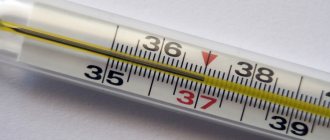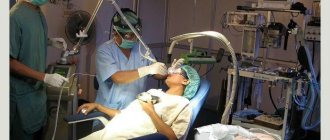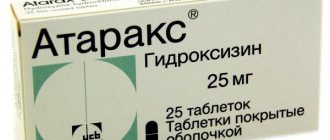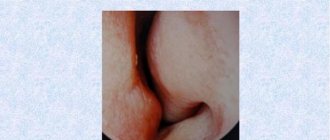Hyperplastic rhinitis is a disease caused by hypertrophy of the nasal mucosa. The growth of nasal tissue changes the shape of the nose, the hardening causes a constant runny nose and problems with normal breathing. The signs of the disease are pronounced, chronic pathology with repeated exacerbations is observed.
Rhinitis of the hyperplastic type must be treated completely, under the supervision of a doctor - the disease causes serious health problems, contributes to the development of chronic forms of nasopharyngeal diseases, and worsens the general condition.
Therapy is selected individually, after diagnostics and laboratory results. Treatment is aimed at eliminating the symptoms of the pathology, and much attention is paid to preventing relapses of the disease.
Causes
A common cause of hyperplastic rhinitis is incompletely treated chronic catarrhal rhinitis. Constant inflammation deprives the mucous membrane of its protective functions. Among the sources of the disease:
- bad habits,
- severe allergies,
- unfavorable conditions in the area of residence,
- decreased immunity,
- chronic diseases of the nasopharynx,
- abnormal structure of the nasal septum due to injury or heredity,
- incorrect use of antibiotics,
- harmful conditions in the workplace.
If a runny nose of a hyperplastic nature forms in childhood, the risk of delayed physical and psycho-emotional development of the child increases significantly.
Symptoms
Changes in the tissue structures of the nose cannot develop asymptomatically. The disease will be indicated by:
- difficulty in nasal breathing, which does not disappear even after using drops,
- dry mouth after waking up,
- snoring even with short sleep,
- feeling of heaviness in the nose, pain in the bridge of the nose,
- deterioration of smell, its complete absence,
- nosebleeds,
- nasal voice,
- hearing loss,
- discharge of yellow mucus mixed with pus that does not disappear under the influence of vasoconstrictor drops,
- slight pain when swallowing,
- spread of infection to the throat, respiratory tract,
- the appearance of signs of hypoxia (overgrown tissue creates problems with oxygen supply),
- deterioration of general condition: weight loss, loss of appetite, memory problems, headaches in the forehead.
Signs of the disease are most pronounced during exacerbations, then disappear and reappear.
Hyperplastic rhinitis: causes, symptoms and treatment
Hyperplastic rhinitis is a fairly common disease, which among otorhinolaryngologists is usually classified as a group of protracted, chronic rhinitis. It is worth noting that the diagnostic process in this case is quite complicated, because the main symptoms resemble a common runny nose. So what is the peculiarity of this disease and what treatment methods are considered the most effective?
Hyperplastic rhinitis: what is it? Signs, features and causes
Hyperplastic rhinitis is a form of inflammation that is accompanied by the proliferation of connective tissue in the nasal passages. Consequently, patients exhibit breathing difficulties and some other problems.
As a rule, adults suffer from the disease; similar rhinitis is diagnosed much less often in children. Symptoms and treatment are certainly interesting points, but first it is worth studying the main causes of the disease.
Despite the fact that the disease has been known for hundreds of years, the exact mechanism of development has not yet been sufficiently studied. However, it was noted that connective tissue proliferation is significantly more often diagnosed in patients with a deviated nasal septum. Other potential causes include:
- chronic sinusitis;
- allergic diseases, which are accompanied by irritation and swelling of the nasal mucous membranes;
- diseases of the lymphatic system;
- decreased activity of the immune system;
- frequent infectious diseases of the respiratory tract;
- inadequate treatment of diseases of the nasopharynx and upper respiratory tract;
- working or living near hazardous industrial enterprises;
- smoking;
- hereditary predisposition.
Hyperplastic rhinitis: symptoms
In the initial stages, the disease is accompanied by the usual symptoms, including nasal congestion and the appearance of mucous discharge.
But as it develops, hyperplastic rhinitis greatly complicates nasal breathing and often becomes the reason for its complete absence. Because of this, patients complain of dry mouth and partial (sometimes complete) loss of smell.
Snoring appears during sleep. The feeling of nasal congestion does not disappear even if the nasal passages are clean.
Hyperplastic rhinitis is accompanied by other symptoms, including:
- sensation of a foreign body in the nose;
- loss of appetite;
- unpleasant, sometimes even painful sensations when swallowing;
- aching headaches;
- frequent nosebleeds;
- hearing impairment;
- the presence of thick mucous discharge from the nose, often mixed with pus.
Due to the proliferation of connective tissues and problems with nasal breathing, the mucous membrane does not receive enough oxygen.
Quite often, an inflammatory process develops, which occurs in waves, sometimes fading, sometimes progressing, and the appearance of purulent, thick discharge in this disease is not considered uncommon.
Even vasoconstrictor drops do not help with congestion. The risk of developing serious bacterial infections increases.
Diagnosis of the disease
Of course, first the doctor must familiarize himself with the patient’s complaints, as well as conduct a physical examination. Hyperplastic rhinitis is accompanied by swelling of the nasal turbinates, pallor of the nasal membranes and hanging ends of the nasal turbinates in the nasopharynx. Spots of an atypical brown or gray color often appear on the mucous membrane.
Naturally, further studies are carried out, including a general blood test and an endoscopic test. A nasal swab is also taken from the patient to determine bacterial infections. Diagnostic methods include radiography and diaphanoscopy. The nasal passages are also examined after using vasoconstrictor drops to determine their effectiveness.
How is hyperplastic rhinitis treated?
Treatment depends on the characteristics of the disease, as well as its possible causes. For example, a person is strongly recommended to quit smoking or change his job if we are talking about harmful chemical production.
Vasoconstrictor drugs are used for treatment, in particular Xymelin, Otrivin, Nazivin. Patients are often prescribed glucocorticosteroids, such as Avamys. Sometimes a mixture of glycerin, glucose and corticosteroids is injected into the nasal passages. Massage of the nasal membrane using “Protargol” and “Splenin” also turns out to be effective.
As for the removal of excess connective tissue masses, modern medicine uses chemical cauterization (for example, trichloroacetic acid), laser therapy, cryotherapy and some other methods. In severe cases, a conchotomy is performed, a surgical procedure during which the doctor removes tissue using medical scissors.
Possible complications of the disease
In the absence of adequate therapy or attempts to cure the disease on your own, complications may develop, including the appearance of chronic nosebleeds, the development of a protracted inflammatory process, lack of nasal breathing and loss of smell.
Unfortunately, complications often spread to other organs. Hyperplastic rhinitis can lead to hearing loss, chronic headaches and pain in the jaw area.
Complications include bronchitis, sinusitis, adenoiditis, sinusitis, and frequent conjunctivitis.
Some patients experience the development of heart failure, problems with the liver and kidneys, a general deterioration in health and decreased performance.
That is why it is so important to detect the disease in time and begin therapy, especially if hyperplastic rhinitis is diagnosed in children. The symptoms and treatment in this case are almost the same as in adult patients, but impaired nasal breathing can cause serious damage to a growing body.
Source: //FB.ru/article/285674/giperplasticheskiy-rinit-prichinyi-simptomyi-i-lechenie
Treatment
The initial stage allows for conservative methods, including:
- taking nasal glucocorticosteroids,
- injections of glycerin, glucose, hormonal agents,
- use of solutions (Collargol, Protargol).
If, with a slight growth of the mucous membrane, there is no obvious progress in treatment, using local anesthesia, the following is prescribed:
- cauterization with acids (chromic, trichloroacetic),
- galvanocaustics,
- exposure to ultrasound,
- laser therapy, mechanical impact on the intraturbinal cavity, cryotherapy.
The specific treatment method for hyperplastic rhinitis is determined by the attending physician.
Surgical treatment involves treating hyperplastic areas with scissors or a loop. Surgery is performed partial, radical, submucosal. Bleeding after surgery is rare.
Drugs
For treatment, medications are prescribed in various dosage forms: sprays, drops, aerosols.
Medicines in the form of sprays
Nasonex. Medicine in the form of a spray. Prescribed for acute manifestations of the disease, 2 injections per day. If the therapeutic effect is weak, increase the number of injections up to 4 times. The medicine is used once a day. When the condition stabilizes, the dosage is reduced to 1 injection.
Hyperplastic rhinitis - symptoms and treatment
Hyperplastic rhinitis is one of the subtypes of the runny nose, which develops not as an independent pathological process, but as a consequence of a chronic disease of the upper respiratory tract.
The disease is difficult to distinguish from a classic runny nose, so only an otolaryngologist can diagnose the pathology and prescribe treatment.
What are the causes of hyperplastic rhinitis, and how to properly treat the disease.
Hyperplastic rhinitis - what is it?
Hyperplastic rhinitis (ICD-10 code: J31.0) is a disease characterized by impaired nasal breathing due to the proliferation of connective tissue in the nasal cavity. The nasal respiratory apparatus is an important system of the human body.
Main functions of upper breathing:
- air intake;
- purification of air from foreign impurities (germs, bacteria, dust particles and gases);
- hydration;
- warming up;
- transport;
- barrier or protective function.
Functional responsibilities are performed by the mucous membrane of the nasal cavity and its tracts. There are three mucous layers, but a special role belongs to the superficial (epithelial) layer, which is represented by three groups of cells:
- Ciliated villi - promote the movement of excess mucus from the nasopharynx to the outlet due to constant movement;
- Glandular - produce mucus, moisturizing the nasal cavity and participating in the immune response;
- Epithelial cells are long and short cells with villous formations.
When exposed to negative environmental factors or exogenous factors, secretion production increases, the volume of mucus increases, and the patient experiences nasal discharge of various types (depending on the cause).
With hyperplastic rhinitis, the middle connective tissue layer is replaced with the superficial epithelial layer. The mucous membrane loses its functionality, nasal breathing is disrupted, and other symptoms arise that confirm the course of the pathological process.
Acute rhinitis gradually enters the chronic stage, while hypertrophic changes continue.
The localization of the process in most cases affects the lower parts of the nasal canals, less often it rises higher, but in both cases the tissue becomes loose, swollen and hyperemic.
In the absence of treatment, hypertrophic areas increase due to active blood supply, cystic neoplasms appear, which sometimes protrude from the nose.
Hyperplastic rhinitis is not a separate type of disease, but the consequences of a runny nose of various origins. Changes of a trophic nature occur in one cavity, less often they affect both.
Timely treatment eliminates the negative consequences of the disease.
What forms are there?
GH is of two types: acute and chronic. The forms differ in the intensity of the clinical picture and the presence of prerequisites for the development of adverse consequences.
- Chronic hyperplastic rhinitis. The most common form, because the initial symptoms and clinical manifestations of the disease are perceived as a common runny nose. Over a long period of time, the replacement of the epithelium with connective tissue leads to the transition to a chronic form of the disease. The development of hGH can be triggered by professional activities (for example, inhalation of gases or vapors), as well as bad habits.
- Acute hyperplastic rhinitis. The disease in its acute form is diagnosed in two cases: if the patient sought timely medical help at the beginning of the development of the disease, when the first prerequisites for the degeneration of glandular and villous epithelium into connective tissue appear;
- in the case of the existing stage of chronicity, which is characterized by the periodic appearance of symptoms of acute rhinitis.
Acute rhinitis with hypertrophic changes is diagnosed in no more than 10% of patients. This is due to delay in seeing a doctor.
Causes of the disease
The occurrence of hyperplastic changes is associated with a long-term inflammatory process in the nasal cavity or nearby anastomoses. Among the many reasons for the development of the disease, the main ones are:
- runny nose, occurring more than 4 times a year;
- long-term and unjustified therapy with topical vasoconstrictors;
- blood vessel diseases;
- pathologies of the ENT organs (for example, sinusitis of various origins);
- viral respiratory diseases;
- bacterial infections of the upper respiratory tract;
- adenoiditis;
- genetic predisposition;
- decreased immunity;
- disruption of the lymphatic system.
Provoking factors occupy a special place.
According to statistics, almost 60% of cases of hyperplastic rhinitis are associated with a deviated nasal septum (congenital anomalies or resulting from mechanical trauma).
About 20% is occupied by professional activities and unfavorable environmental situations, for example, living in a dangerous gas-polluted area. Production reasons include:
- inhalation of vapors or gases;
- work with chemical compounds;
- contact with metal or glass dust;
- inhalation of combustion products;
- working with hazardous waste.
Allergies and smoking are also factors that provoke hypertrophy of the nasal passages. In heavy smokers, the disease occurs only in a chronic form and is more difficult to treat.
Symptoms
The clinical picture of the disease is very similar to a runny nose of viral origin. Patients experience the following symptoms:
- Initially, the patient complains of difficulty in nasal breathing, and the medications used do not bring relief.
- The mucous discharge is scanty and thick, sometimes with a slightly yellowish tint.
- A dry cough and snoring appears.
- Chronic headaches.
- Sleep disturbance and loss of appetite.
- Tinnitus, periodic deafness in the ear on the side where the nasal cavity is affected.
- Nasal voice, hoarseness, sniffling.
- Apathy, loss of ability to work.
Patients become irritable and have difficulty perceiving information due to oxygen deficiency. Often the pathological process affects the organs of vision and bronchi. Third-party infections occur.
The clinical picture of the disease is different: some patients complain of copious mucus secretion, others complain of a strong dry cough and swelling of the nasal passages without mucous discharge. The nature of hyperplastic rhinitis depends on the individual characteristics of the patient.
It is difficult to establish a diagnosis based on symptoms, but upon examination of the nasal passages, the doctor can suggest a disease. Upon external examination, the mucous membrane looks dry, loose, and increased in size. There is a change in its color from pale pink to purple-red.
Diagnostics
To confirm the diagnosis, the otolaryngologist prescribes a number of diagnostic procedures. First of all, the doctor collects the patient’s medical history and notes the patient’s complaints. Then the necessary diagnostic measure is rhinoscopy of the nasal sinuses and palpation of the sinuses to identify the pathological process.
It is difficult to diagnose hyperplastic rhinitis by external signs, so it is necessary to undergo the necessary tests, as well as undergo fluoroscopy of the paranasal sinuses and nasal cavity, respectively.
The patient undergoes a general blood test, and a scraping is taken from the nasal passages for bacteriological examination. In more severe cases, diaphanoscopy is prescribed.
Treatment
Therapy for the disease includes not only taking medications, but also mandatory lifestyle changes. Doctors often advise changing professional activity or place of residence with easier climatic conditions.
- Treatment with drugs. To get rid of the disease, vasoconstrictor drops and local glucocorticosteroids are used. The first group includes:
- Otrivin - drops or spray. The product moisturizes the mucous membrane, eliminates swelling and minimizes the amount of mucous secretion.
- Nazol is an affordable drug that relieves swelling and restores nasal breathing.
Xymelin - drops with a vasoconstrictor local effect.
An important point is that the drops cannot be used for more than 5 days, but you can change them periodically, increasing the period of use to 10 days.
Of the GCS used in the treatment of hyperplastic rhinitis, the most popular are Nasonex and Desrinit. The dosage and treatment regimen are determined by the doctor.
- cryodestruction;
The method of operation is chosen by the doctor according to indications and the presence of complications. According to statistics, hyperplastic changes in the nasal cavity are completely eliminated by surgical methods.
How to treat at home?
Home treatment methods are aimed at restoring immunity and maintaining the body's defenses. It is impossible to cure a runny nose with trophic changes using folk remedies.
In addition, the use of medicinal decoctions and infusions can provoke an allergic response and significantly aggravate the disease. For oral administration, tinctures based on chamomile, St. John's wort and sage are prepared.
In the absence of allergies, it is allowed to instill thuja oil into the nose to moisturize the mucous membrane and stimulate local immunity, and peach oil to avoid the formation of dry crusts.
Consequences of not treating
Chronic hyperplastic rhinitis, if left untreated, can cause the development of inflammatory processes in the lower respiratory tract (tracheitis, bronchitis, pneumonia). It is also an infectious source for the occurrence of sinusitis, and less often causes insufficiency in the circulatory system and heart, due to acute and prolonged oxygen deficiency.
Prevention
Preventing the disease is easy. It is enough to treat a runny nose in time and seek medical help if the illness does not subside for more than 4 days.
Maintain your immune system, take vitamins and monitor your diet. It is especially important to give up bad habits and avoid contact with sick people. Do not overcool, follow the rules of hygiene, and after visiting the street, rinse your nasopharynx with saline solution.
Hyperplastic rhinitis is a disease that can be prevented without much effort. Patients prone to this type of rhinitis should be attentive to their health and stop smoking.
Persons with a predisposition to the disease, or with a history of the disease, are recommended to visit places with a warm, humid climate more often, for example, the sea coast or salt baths.
Timely treatment will eliminate negative consequences and prolong the period of remission.
Source: //LechiNos.ru/zabolevaniya/rinit/giperplasticheskij-rinit/
Complications
Hyperplastic rhinitis is dangerous due to the development of a number of serious complications with the formation of:
- partial loss of hearing, sense of smell,
- chronic headaches,
- pathologies of the nasopharynx: bronchitis, sinusitis, tracheitis, adenitis, tonsillitis,
- nosebleeds,
- deterioration of health,
- aching pain in the jaw area,
- circulatory disorders in the nose,
- predisposition to infections in the nasal cavity,
- disorders of the gastrointestinal tract, kidneys, liver,
- conjunctivitis,
- disorders of the heart (heart failure),
- chronic sinusitis,
- difficulty breathing in and out.
A timely visit to an otolaryngologist will help you avoid unwanted developments.
Prevention
The main purpose of prophylaxis is to prevent the progression of the catarrhal form of the runny nose into hyperplastic rhinitis. Those who have problems with the nasopharynx should follow a certain “health code”, namely:
Monitor your own health:
- avoid hypothermia,
- promptly treat sinusitis, infectious diseases of the nasal cavity,
- get rid of caries,
- Avoid taking antibiotics without a doctor's prescription.
Lead a healthy lifestyle:
- to refuse from bad habits,
- toughen up, spend more time in the air,
- engage in moderate exercise and sports,
- normalize nutrition, avoid vitamin deficiency.
For allergy sufferers and patients with frequent manifestations of rhinitis:
- rinse your nose with an isotonic and antibacterial solution,
- moisturize the nasal passages,
- control allergic reactions with indicated medications.
The listed measures should be made rules of life in order not only to protect yourself from the runny nose in various forms and degrees of development, but also to maintain health for many years.
Diagnostics
The signs of the disease are difficult to distinguish from the symptoms of chronic rhinitis, so only an experienced otolaryngologist can diagnose it. First of all, he pays attention to external manifestations - swelling, tissue growth in the nasal cavity, the presence of pus in the secreted secretions, spots on the mucous layer.
The following procedures are carried out as additional studies:
- smear;
- blood analysis;
- endoscopy;
- radiography;
- diaphanoscopy;
- examination of the internal cavity after using a vasoconstrictor.











